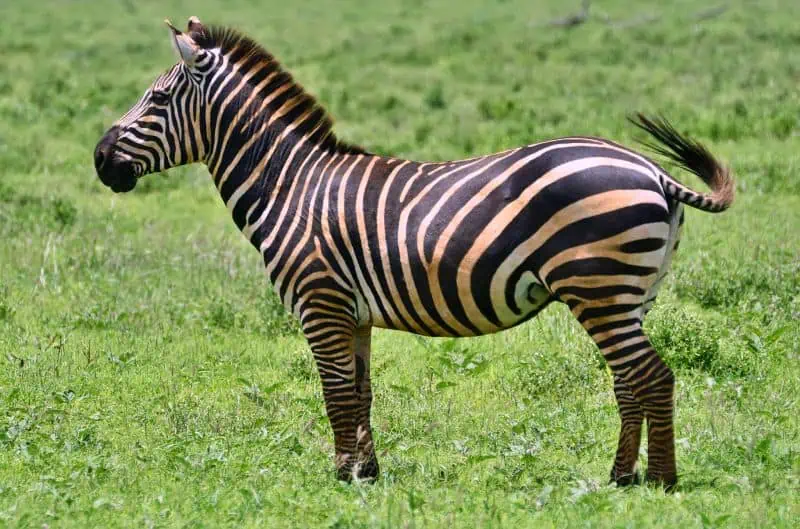Plains zebra

Scientific name:
Equus quaggaSize:
Up to 1.50m in height, 2.50m in length
IUCN Status:
Near Threatened
Weight:
Up to 320 kgs (males) / 250 kgs (females)
Share this page
Endangered species
Vervet Monkey
Plains zebra
Malachite kingfisher
Nile crocodile
Goliath Frog
Range
The plains zebra is the most widespread zebra species, found across 17 countries in East and Southern Africa.
Diet
The plains zebra, known as a pioneer grazer, is highly adaptable and non-selective in its food sources. It feeds on both long and short grasses, including tough varieties, and can dig for roots and rhizomes during the dry season, showcasing its remarkable dietary flexibility.
Description
The plains zebra is recognizable by its bold, horizontal stripes and compact body, making it the most common of the three zebra species, which include the mountain zebra and Grevy’s zebra. A highly social species, the plains zebra typically lives in groups called harems, where females are led by a single stallion. Young mares are often willingly “abducted” by harem-leading males and tend to remain loyal to the male who successfully impregnates them. Male-only groups, especially among younger individuals, also exist. Both sexes display hostility toward newcomers in the group, as harem hierarchies determine breeding priority. Harems may congregate into larger herds during migrations or specific events, providing better protection against predators. Group cooperation, including tending to foals and other members, enhances survival chances.
Plains zebras are preyed upon by a variety of carnivores, including lions, crocodiles, hyenas, and African wild dogs. Young foals may also fall victim to leopards, cheetahs, or jackals. To avoid predators, zebras prefer open environments and often share habitats with other species, such as gazelles and wildebeests.
Plains zebra populations have declined in more than half of their native range, leading the species to be classified as Near Threatened by the IUCN in 2016. Habitat encroachment and competition with cattle pose significant risks to their survival. Despite these challenges, the plains zebra holds a prominent place in African culture, valued for its striking appearance and symbolism. Its iconic stripes have even influenced cultural elements, such as the design of Botswana’s national flag.
Threats to survival
The plains zebra population across Africa is estimated at around 500,000 individuals, but the species faces significant threats from human activities, leading to local extinctions in parts of the continent. Key factors contributing to these declines include:
- Habitat Destruction: As a migratory species, the plains zebra depends on navigating vast environments to find safe areas for feeding and breeding during harsh seasons. Human activities such as fencing, road construction, and land conversion restrict their movements, leading to inbreeding and increased predation risks.
- Overhunting and Poaching: Plains zebras are hunted for their skins and meat. Overexploitation has already caused the extinction of the quagga, a subspecies of the plains zebra.
- Climate Change: Severe droughts caused by climate change directly impact survival rates. Unlike other zebra species, plains zebras are more water-dependent, making them especially vulnerable to water shortages that can decimate entire populations.
- Competition with Domestic Herbivores: Livestock, particularly cattle, competes with zebras for grazing resources. Cattle, often managed and protected by humans, dominate grasslands, including areas once used by wild herbivores, further reducing the zebras’ food availability.
These combined challenges highlight the importance of conservation efforts to protect the plains zebra and its habitat.
Conservation efforts
Rethinking Infrastructure: Ensuring habitat connectivity through wildlife corridors can significantly reduce the impact of habitat encroachment on migratory herbivores like zebras, allowing them to navigate safely and access vital resources.
Community Engagement: Educating local communities about the ecological importance of wild herbivores and the effects of cattle grazing on adjacent habitats is crucial for preventing the local extinction of species, including the plains zebra.




